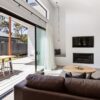Shadow & Sand: The Definitive Guide to Earthy Japandi Styling
Forget the sterile white walls. The evolution of Japandi interior design has moved into the shadows. We are leaving behind the ‘light oak and white’ standard and descending into something far more visceral, grounded, and sophisticated: a palette of earthy beige, rich browns, and anchoring blacks. This is Shadow & Sand styling.
If you have been following the trajectories of Architectural Digest or the muted mood boards of Copenhagen’s elite, you know that the intersection of Japanese rustic minimalism (Wabi-Sabi) and Scandinavian functionality (Hygge) is shifting. It is no longer just about brightness; it is about depth.
The Philosophy: Why Go Darker?
The initial wave of Japandi was predominantly airy—a reaction to the clutter of maximalism. However, a space that is entirely beige and white can sometimes feel weightless, almost temporary. By introducing Deep Brown (walnut, espresso, burnt umber) and Matte Black (charcoal, iron), we introduce “gravity” to the room.
To nail this aesthetic without making your home look like a cave, follow this ratio:
70% Earthy Beige/Sand: Walls, large textiles, flooring (the canvas).
20% Rich Brown: Furniture, wood accents, ceramics (the warmth).
10% Matte Black: Light fixtures, hardware, picture frames (the anchor).
This triad works because it mimics nature. Think of a forest floor: the pale sandy soil, the dark bark of ancient trees, and the deep shadows cast by the canopy. It is primal, and therefore, intrinsically relaxing.

The Palette: Deconstructing the Triad
1. The Base: Not Just “Beige”
When we say beige, we aren’t talking about that yellow-undertoned builder’s beige from the 1990s. We are talking about “Greige,” “Oatmeal,” and “Plaster.” You want a textured visual silence. According to Elle Decor, the trend for 2025 is moving toward limewash walls, which add a velvety texture that flat paint cannot achieve.
2. The Warmth: Brown & Wood
In standard Scandi design, white oak or birch is king. In Earthy Japandi, we look to Walnut, Teak, and stained Ash. You want woods that feel “cooked”—rich, chocolatey tones that absorb light rather than reflect it.
3. The Anchor: The “Sumi” Black
In Japanese calligraphy, Sumi ink is used to create definition. In your home, black serves the same purpose. It outlines the space. A black dining chair silhouette against a beige wall is high art.
The “Must-Have” Edit
Textures & Materials: The Tactile Experience
Since we are working with a muted palette, texture is where you create interest. If everything is smooth, the room will feel flat. You need friction.
- Bouclé & Linen: Soft, nubby fabrics that catch the light.
- Raw Concrete: Use this for planters or coffee tables to introduce an industrial “brutalist” edge that complements the softness.
- Shou Sugi Ban: This is the Japanese art of charring wood to preserve it. It results in a stunning, textured black finish that is far superior to painted black wood.
Wabi-Sabi Alert
Do not buy perfect things. A crack in a ceramic bowl, a frayed edge on a linen throw, or a knot in the wood table—these are celebrated imperfections. They tell a story of time passing. This is the heart of the aesthetic.
Room-by-Room Styling Guide
The Living Room: The Sanctuary
Start with a large, beige jute or wool rug to define the zone. Layer a smaller, darker vintage rug on top for depth. Your coffee table should be organic in shape—no sharp corners. Think kidney-bean shapes or rounded stone.
The Art of Styling: Avoid the “gallery wall” cluttered look. Instead, opt for one massive piece of art—perhaps a large canvas painted in black strokes on a beige background, or a large woven tapestry.
The Kitchen: Functional Minimalism
Hide the appliances. Japandi kitchens are notorious for their “un-kitchen” look. Cabinetry should be handle-less, ideally in a dark walnut or matte beige finish. Countertops look best in honed stone (matte) rather than polished granite.

Lighting: The “In Praise of Shadows” Concept
Lighting is perhaps the most critical element. You must avoid the “big light” (central ceiling light) at all costs. As referenced in the seminal text In Praise of Shadows by Jun’ichirō Tanizaki, beauty lies in the dimness.
Layer your lighting:
- Floor level: Uplighters behind plants.
- Table level: Ceramic lamps with linen shades.
- Eye level: Sconces that wash the wall with light.
Quiz: Is Your Space Ready for Dark Japandi?
Click the statement that best describes your current living room:
Conclusion: A Lifestyle, Not a Trend
Adopting the Earthy Beige, Brown, and Black Japandi style is a commitment to tranquility. It requires you to be a curator of your own life. Every object in your home should serve a purpose or spark deep joy. By grounding your home in these earth tones, you build a sanctuary that feels safe, warm, and timeless.
Ready to transform your space? Start with the paint. Go two shades darker than you think you should. Trust the shadows.
















